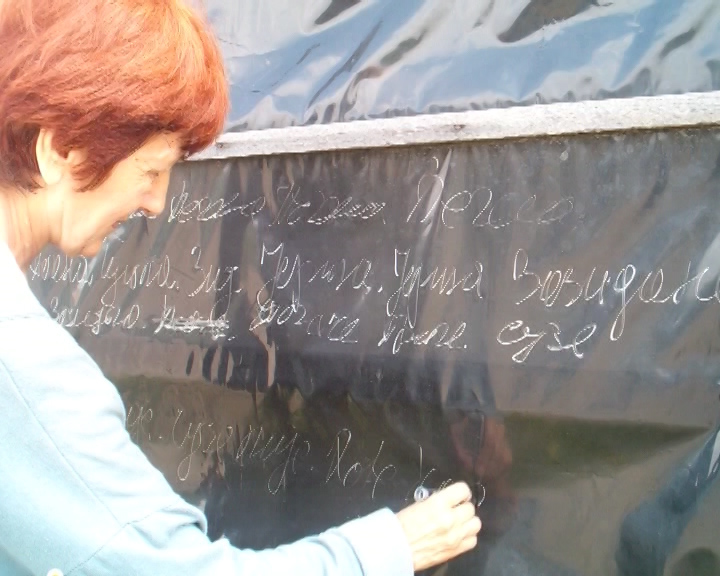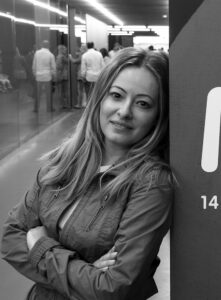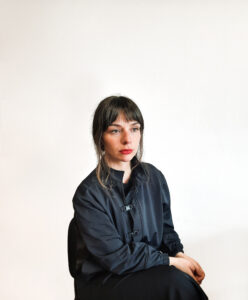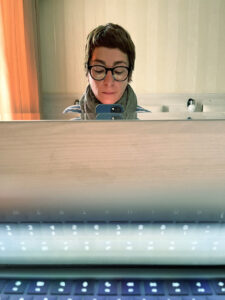Marica Radojčić

– (1943, Novi Karlovci – 2018, Belgrade) completed her bachelor’s (1966), master’s (1969) and Ph.D. (1972) studies in mathematics at the Faculty of Science and Mathematics (today Faculty of Mathematics), where she was a Professor. Her mathematical works belong to the fields of universal algebra, mathematical logic, numerical mathematics and mathematical linguistics. She published more than forty scientific papers, which were cited by many scientists around the world, among others A. G. Kurosh (Abstract Algebra), G. Grätzer (Universal Algebra), D. Pigozzi (Universal Equational Theories and Varieties of Algebras, Annals of Mathematical Logic). She was the founder of the Mathematical Art Workshop (1993), and the Art and Science Association (1998), as well as the co-founder of the digital art group at the interdisciplinary master’s studies of the University of Arts in Belgrade (2000).
In the language of art, Marica Radojčić1 intertwines philosophy, mathematics and metaphysics, and is one of the pioneers in combining art and science, as well as computer-generated art in Serbia. She was a member of the Association of Fine Artists of Serbia (ULUS) as well as the Internationales Künstler Gremium (IKG). Marica Radojčić was the recipient of a Fulbright scholarship for mathematics (1985-1986), and as a visiting researcher or professor had residencies at several high-ranking universities in the world (in Bonn, Hamburg, Moscow, Berkeley, Stanford, New York and others). These study residences enabled her to gain insight into the international art scene, and to develop valuable contacts, among others with Bertha Urdang and Eric Stark, thanks to whom her works are still being exhibited more abroad than in Serbia.
There was an IN MEMORIAM program dedicated to Marica Radojčić as part of the Expanded Media Triennial “Reconnection” held in 2019, organised by ULUS.2
The artist herself writes about her art:
“My art is experimental and until twenty years ago it was mostly visual. Then I started experimenting with performance as well as with sound. Based on mathematics and philosophy, which is usually present in some deeper layers, several ideas are dominant:
– Infinity (which is closely related to the idea of God)
– Death (especially the thin line between life and death)
– Language (natural and abstract languages, roots of natural language, layers of meaning, language as a visual medium…)
– Branching (as a special type of potential infinity present in many aspects of human life, but also in theoretical sciences such as mathematics, physics, computer science)
– Human limits (limits of our world, free will, knowledge…) and
– Science and Art”3
A selection from the Lepenski Vir cycle4
“The cycle was created in 1981-1982. It has a total of 21 works, oil on canvas and Indian ink drawings (…). That cycle is significant because it was there that I first started using my handwriting as an art medium. As language is one of the central themes of my creativity, both scientific and artistic, I think it would be good if the gift collection shows the developmental thread of the presence of language in my artwork from the very beginning until today.”
Selection from the project Words…
“This was a long-term project, related to my research on the origin of language, primarily on the issue of the origin of letters. It consists of about 10 large format works on paper (mixed media: raw pigment pressed into paper, pencil, ink,…) and several sculptures that were destroyed in the meantime, but some of them could be recreated.”
The entire exhibition Periodically
“The exhibition was held in Belgium, in Ghent, in 1998, in one of the most important European spaces for contemporary art – Experimental Intermedia. It consists of a dozen smaller hanging sculptures and light effects. At that exhibition, completely surprising the Belgian audience who expected an exhibition full of computers and modern technologies, I began to completely unconsciously deal with the theme of death, with which I will soon have a close encounter in reality.”
The entire exhibition Return of the Departure5
“The exhibition was held in 2002, at the Gallery of the Cultural Centre of Belgrade. With it, the research on the subject of death, or rather the thin line between life and death, was elevated on the mathematical-philosophical level and brought under the umbrella of my long-term research on paradoxes. The exhibition is, in fact, a virtual space in which the illusion of the inside of my stomach is created with the help of digital animations achieved with the latest powerful software, using modern technological means. A paradoxical situation in which the reversal of the relation interior ➝ exterior is examined in the opposite, paradoxical direction, reaching the outermost ranging possibilities of the state-of-the-art technologies.”
The entire exhibition Branching6
“The project was first shown in 2004, at my solo exhibition at the Kunstlerhaus, in Klagenfurt, Austria. It was then exhibited at the Museum of Estonian Architecture in Tallinn, that same year, and this year in March, at the Medienwerkstatt in Vienna. (…) In Branching, mathematics, which until now has always been in some deeper layers of my art, was brought to the surface for the first time. Surprisingly, this is exactly what the audience and experts appreciated the most. The project consists of drawings, digital graphics (on paper and silk fabric), digital animations, and original digital sound – also created by me. Precisely this mathematical, but very poetic, is the reason why I think that this project should find a place among the works I am giving away.”789
The text was edited by Dejan Vasić, with great appreciation for the help and trust of colleagues from the Gallery of Matica Srpska in Novi Sad, and Petar Laušević for initial consultation (2022).
1Many sources, professional literature and catalogues cite Marica Radojčić Prešić, during the period when she was married to Slaviša Prešić. After the divorce, when she would mention her ex-husband, she would say Professor Prešić. According to the artist, they drifted apart due to political differences... my husband's complete deviation into nationalism, which horrified me, and some anxiety and alienation... (M.R). Quoted in Sanja Kojić Mladenov "Leap and Dive: Discourses on Gender in Art: The Construction of the Professional Identity of Female Artists in the Field of New Media in Vojvodina at the End of the 20th and the Beginning of the 21st Century", p. 46, ProArtOrg, Belgrade 2020, p. 1172After a short introduction in Serbian (1 min), the rest of the video is in English. Link: https://www.youtube.com/watch?v=I6WHW48mTvM&t=3s
3Radojčić, Marica (2012). Digital - Biological, (unpublished, author’s collection), listed in Sanja Kojić Mladenov "Leap and Dive: Discourses on Gender in Art: The Construction of the Professional Identity of Female Artists in the Field of New Media in Vojvodina at the End of the 20th and the Beginning of the 21st Century", p. 46, ProArtOrg, Belgrade 2020.
4Marica Radojčić Lepenski 4, oil and Indian ink on canvas, 1982. Courtesy of the Gallery Matica Srpska.
5Marica Radojčić Return of the Departure, video. Courtesy of the Gallery Matica Srpska.
6Marica Radojčić Branching, video. Courtesy of the Gallery Matica Srpska.
7From the letter by Marica Radojčić addressed to Branka Kulić, president of the Board of Directors of the Gallery Matica Srpska, in which the artist endows the works that make up the Gift-Collection of Marica Radojčić, which today includes more than seventy works.
8Link: A view of the installation of Marica Radojčić's exhibition "Branching" held at the art gallery “Dr. Vinko Perčić” in Subotica in 2016. https://www.youtube.com/watch?v=kz0eTuYl55w
9Link: The segment from Television Novi Sad on the occasion of the establishment of the New Media Collection of the Gallery Matica Srpska. https://www.youtube.com/watch?v=Y497wTvphpQ
Marica Radojčić (1943, Novi Karlovci – 2018, Beograd) diplomske (1966), magistarske (1969) i doktorske (1972) studije matematike završila je na Prirodno-matematičkom fakultetu u Beogradu, na kojem je bila u zvanju redovne profesorke. Njeni matematički radovi pripadaju oblastima univerzalne algebre, matematičke logike, numeričke matematike i matematičke lingvistike. Objavila je više od četrdeset naučnih radova, koje su citirali mnogi naučnici širom sveta, između ostalih G. Kuroš (Apstraktna algebra), G. Gratzer (Univerzalna algebra), D. Pigozzi (Universal Equational Theories and Varieties of Algebras, Annals of Mathematical Logic). Bila je osnivačica Matematičke umetničke radionice (1993), i udruženja Umetnost i nauka (1998), kao i koosnivačica grupe za digitalnu umetnost na interdisciplinarnim magistarskim studijama Univeziteta umetnosti u Beogradu (2000).
U jeziku umetnosti, Marica Radojčić1 prožima filozofiju, matematiku i metafiziku, i jedna je od pionirki u spojanju umetnosti i nauke, kao i kompijuterski generisane umetnosti u Srbiji. Bila je članica Udruženja likovnih umetnika Srbije (ULUS) kao i Internationales Künstler Gremium (IKG). Marica Radojčić bila je dobitnica Fulbrajtove stipendije za matematiku (1985-86), a kao gostujuća istraživačica ili profesorka boravila na više poznatih univerziteta u svetu (u Bonu, Hamburgu, Moskvi, Berkliju, Stenfordu, Njujorku i drugim). Ovi studijski boravci omogućili su joj da stekne uvid u međunarodnu umetničku scenu, i da ostvari značajne kontakte, između ostalih sa Bertom Urdang i Erikom Starkom, zahvaljujući kojima su njena dela i danas više izlagana u inostranstvu nego u matičnoj zemlji.
U okviru Trijenala proširenih medija „Rekonekcija“ održanog 2019. godine u organizaciji ULUS-a, održan je IN MEMORIAM program posvećen Marici Radojčić.2
Sama umetnica piše o svojoj umetnosti:
„Moja umetnost je eksperimentalna i do pre dvadeset godina je bila uglavnom vizuelna. Zatim sam počela da eksperimentišem sa performansom, kao i sa zvukom. Na osnovu matematike i filozofije, koja je obično prisutna u nekim dubljim slojevima, dominantno je nekoliko ideja:
– Beskonačnost (koja je blisko povezan sa idejom Boga)
– Smrt (naročito tanka linija između smrti i života)
– Jezik (prirodni i apstraktni jezici, koreni prirodnog jezika, slojevi značenja, jezik kao vizuelni medij…)
– Grananje (kao posebna vrsta potencijalne beskonačnosti prisutna u mnogim aspektima ljudskog života, ali i u teorijskim naukama kao što su matematika, fizika, informatika)
– Ljudske granice (granice našeg sveta, slobodne volje, znanja …) i
– Nauka i Umetnost“3
„Izbor iz ciklusa Lepenski Vir4
Ciklus je nastao 1981-2, broji ukupno 21 rad, ulja na platnu i crteza tusem (…). Taj ciklus je značajan po tome što sam tu prvi put počela da koristim svoj rukopis kao likovni medij. Kako je jezik jedna od centralnih tema mog stvaralaštva, kako naučnog tako umetničkog, smatram da bi bilo dobro da u poklon zbirci bude prikazana razvojna nit prisustva jezika u mojim umetničkim delima od samog početka pa sve do današnjih dana.
Izbor iz projekta Reči. ..
Projekt je bio dugoročan, odnosio se na moja istraživanja o poreklu jezika, prvenstveno na pitanja porekla slova. Sastoji se od 10-ak radova na papiru (kombinovana tehnika: sirov pigment utisnut u papir, olovka, tuš,…) velikog formata i nekoliko skulptura koje su u međuvremenu uništene, ali bi se neke od njih mogle ponoviti.
Cela izložba Periodically (Periodično)
Izložba je bila u Belgiji, u Gentu, 1998, u jednom od najznačajnijih evropskih prostora savremene umetnosti – Experimental Intermedia. Sastoji se od desetak manjih visećih skulptura i svetlosnih efekata. Na toj izložbi, potpuno iznenađujuće za belgijsku publiku koja je očekivala izložbu punu računara i modernih tehnologija, počinjem potpuno nesvesno da se bavim temom smrti, sa kojom ću ubzo u stvarnosti imati blizak susret.
Cela izlozba Povratak odlaska5
Izložba je bila 2002. u Galeriji Kulturnog centra Beograda. Njome je istraživanje teme smrti, tačnije tanane linije između života i smrti, podignuto na matematičko-filosofsku ravan i podvedeno pod moja dugogodišnja istraživanja o paradoksima. Izložba je, u stvari, virtuelni prostor u kome se stvara iluzija unutrašnjosti mog stomaka pomoću digitalnih animacija ostvarenih na najnovijim moćnim softverima upotrebom savremenih tehnoloških sredstava. Paradoksalna situacija u kojoj se istražuje obrtanje relacije
unutrašnjost–>spoljašnjost
u suprotnom, paradoksalnom smeru, pri čemu se dodiruju rubne mogućnosti dometa najsavremenijih tehnologija.
Cela izložba Branching (Grananje)6
Projekt je prvi put prikazan na mojoj samostalnoj izložbi u Kunstlerhaus, Klagenfurt, Austrija 2004. godine. Potom je izlagan u Muzeju arhitekture u Talinu, Estonija, iste godine, a ove godine u martu u Mediawerkstatt-u u Beču. (…) U Grananju je prvi put matematika, koja je do sada uvek bila u nekim dubljim slojevima moje umetnosti, izvučena na samu površinu. Začudo, upravo to se publici i stručnjacima posebno svidelo. Projekt se sastoji od crtreža, digitalnih grafika (na hartiji i na svilenoj tkanini), digitalnih animacija, i originalnog digitalnog zvuka – takođe mog ostvarenja. Upravo ta matematičnost, ali vrlo poetska, je razlog što mislim da bi taj projekt trebalo da nađe mesta među radovima koje poklanjam.“789
Tekst je priredio Dejan Vasić, uz veliku zahvalnost na pomoći i poverenju koleginica i kolega iz Galerije Matice srpske u Novom Sadu, i Petru Lauševiću na incijalnim konsultacijama (2022).
1U mnogim izvorima, stručnoj literaturi i katalozima navođeno je Marica Radojčić Prešić, u periodu dok je bila u braku sa Slavišom Prešićem. Nakon razvoda kada bi spominjala bivšeg supruga govorila bi profesor Prešić. Prema navodima umetnice udaljili su se zbog političkih razlika: …potpuno nacionalno zastranjivanje mog supruga, koje me je užasavalo, i neka uznemirenost i otuđenost... (M.R). Navedeno u Sanja Kojić Mladenov „Skok i Zaron: Diskursi o rodu u umetnosti: konstrukcija profesionalnog identiteta umetnica u oblasti novih medija u Vojvodini krajem 20. i početkom 21. veka“, str. 46, ProArtOrg, Beograd 2020.str. 1172Link: https://www.youtube.com/watch?v=I6WHW48mTvM&t=3s
3Radojčić, Marica. (2012). Digitalno – Biološko, (neobjavljen, kod autorke), navedeno u Sanja Kojić Mladenov „Skok i Zaron: Diskursi o rodu u umetnosti: konstrukcija profesionalnog identiteta umetnica u oblasti novih medija u Vojvodini krajem 20. i početkom 21. veka“ str. 46, ProArtOrg, Beograd 2020.
4Marica Radojčić Lepenac 4, ulje i tuš na platnu, 1982. Ljubaznošću Galerije matice srpske.
5Marica Radojčić Povratak odlaska, video. Ljubaznošću Galerije Matice srpske.
6Marica Radojčić Grananje: Lili-Orannž, video. Ljubaznošću Galerije Matice srpske.
7Iz pisma Marice Radojčić upućenog Branki Kulić, upravnici Galerije Matice srpske, u kojem umetnica poklanja radove koji čine poklon-zbirku Marice Radojčić koja danas broji više od sedamdeset radova.
8Link: Pogled na instalaciju izložbe Marice Radojčić „Grananje“ održanoj u galeriji dr. Vinko Perčić u Subotici 2016. godine. https://www.youtube.com/watch?v=kz0eTuYl55w
9Link: Prilog Televizije Novi Sad povodom osnivanja zbirke Novih Medija Galerije Matice srpske. https://www.youtube.com/watch?v=Y497wTvphpQ


